Posts Tagged ‘Nail Fungus Remedies’
Fungal Toenail Infections and Using Home Remedies
Fungal Toenail Infections and Using Home Remedies
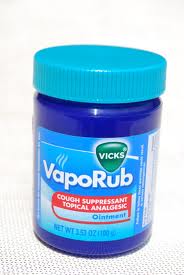 When people think of the phrase ‘home remedy’ they envision something that has been passed down through generations of family members and passed through many people by word of mouth. This is fairly accurate. As most of our grandparents and great grandparents grew up in a time when going to the doctor wasn’t as easy as it is today and when medicinal compounds weren’t that far away from what was already available in the house, many home remedies may seem strange, but especially in the case of fighting toenail fungus, they just may work!
When people think of the phrase ‘home remedy’ they envision something that has been passed down through generations of family members and passed through many people by word of mouth. This is fairly accurate. As most of our grandparents and great grandparents grew up in a time when going to the doctor wasn’t as easy as it is today and when medicinal compounds weren’t that far away from what was already available in the house, many home remedies may seem strange, but especially in the case of fighting toenail fungus, they just may work!
There are a great many home remedies suggested for sufferers of toenail fungus and even more people will agree that they are effective. Everything from soaking your feet in Listerine or vinegar to applying Vicks VapoRub, bleach, peroxide or various essential oils to the affected area are circulating out there. Whereas the intelligence behind putting bleach directly on your skin is questionable, there are online-forums-worth of people who will swear by this and other methods.
Some useful remedies
The theory behind many of these treatments is that the fungus requires a certain environment to grow in, which includes a favorable pH level. Soaking your feet in something like a solution of vinegar and water would alter that pH level rather drastically and make the growing environment more hostile. One problem with this particular method is that soaking your whole foot in vinegar changes the pH in every area your skin comes into contact with the solution, which frequently dries out the skin, leaving it more prone to infection. A viable alternative is to soak a cotton ball in vinegar and place that on the affected area for 15-20 minutes. This isolates the vinegar to the places it is most needed and doesn’t damage the healthy skin surrounding the infection. This technique also works with the suggestion of Listerine.
“Why Vicks VapoRub?” many people ask. The common theory is that it has to do with the eucalyptus in the product. The results are fairly unanimous from those who have tried it, it really works to clear up toenail fungus, and works fast. If you choose this method, you must cover the entire affected area and rub the compound in well. Reports state that the infection starts to clear up within days.
Using rubbing alcohol or peroxide, applied to the nail, the surrounding area and under the nail bed if possible, are two other very common remedies. The likelihood of irritation is fairly high with these two but they have also been proven effective at killing toenail fungus.
All of the remedies listed here have shown to be effective at slowing, killing and/or removing toenail fungus. But, as when using any home remedy, you must use a bit of common sense. If the infection gets worse or if the skin around the infected nail becomes irritated and infected as well, stop treatment immediately and see your doctor. Most of these remedies are for the early stages of toenail fungal infections and should not be started if your toe is already oozing pus or if the nail has separated from the nail bed. Again, if this is your situation, contact your health care professional right away.
Home Remedies to Cure Nail Fungus
Home Remedies to Cure Nail Fungus
Is there any evidence that they work?
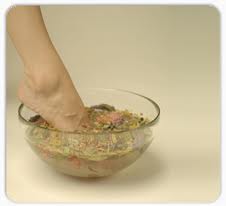 Many people suffer from onychomycosis, more commonly known as nail fungus or toenail fungus. Prescription drugs are available to cure this condition but many of them have been found to have side effects, such as Liver Damage, that can be severe. Because of this factor, people who have this condition search out alternative remedies to treat their onychomycosis. This begs the question, “Do these home remedies work? And if so, are they safe and which ones are the most effective?”
Many people suffer from onychomycosis, more commonly known as nail fungus or toenail fungus. Prescription drugs are available to cure this condition but many of them have been found to have side effects, such as Liver Damage, that can be severe. Because of this factor, people who have this condition search out alternative remedies to treat their onychomycosis. This begs the question, “Do these home remedies work? And if so, are they safe and which ones are the most effective?”
Several different home remedies have been suggested over the years for onychomycosis and other nail fungus treatment. Clinical trials have not been run on any of these home remedies; however there is anecdotal evidence that many of them do work. Sometimes it depends on the individual, or the kind of nail fungus they have, as to which remedies work and which don’t. Another factor is the ability of the remedy to get under the nail sheath and reach the infected area, which is usually underneath and in the nail bed itself. In favor of the home remedy, there is usually little to no risk of making anything worse than it already is, and these are usually inexpensive to try.
If the nail bed and lunula are affected, topical and over the counter medicines will not be effective, which also eliminates most home remedies. In these cases the only cure is an oral medication which requires a prescription from a doctor.
Remedy suggestion #1: Listerine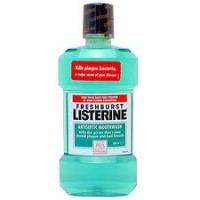
Listerine, a mouthwash that advertises the destruction of bacteria that cause gum disease is a very popular and inexpensive treatment for finger or toenail fungus. After all, if it destroys one kind of bacteria, why shouldn’t it be effective for getting rid of other kinds of bacteria? Ingredients in Listerine are ethanol, thymol, eucalyptol (from eucalyptus), and benzoic acid.
Standard treatment for onychomycosis using Listerine is to soak the affected area in Listerine for 10 minutes every night until the affected area clears.
Onychomycosis is caused by a few different factors. Infection from Candida is one of them, so if the Listerine can penetrate to the site of the infection, it is possible, even probable that this will be an effective treatment as Listerine has been shown to be effective against Candida. Another cause of onychomycosis is dermatophyte, which have not been demonstrated to be as negatively affected by Listerine’s chemical make-up. As the majority of onychomycosis are caused by dermatophyte, Listerine may not be effective in all cases of nail fungus as a home remedy.
Remedy suggestion #2: Vinegar
Vinegar, with its acidic environment helps to destroy the dermatophyte that cause onychomycosis. Also known as acetic acid, this remedy is made up of one part vinegar and two parts water. By soaking the affected area for 20 minutes per day, the acetic acid is able to create a less habitable climate for the fungus, thus discouraging its continued growth. Continue treatment until the affected area clears up. It is also possible that the skin around your nail will become irritated. If this is the case, treatment should be discontinued.
There has been no significant difference discovered in using apple cider vinegar vs. white vinegar nor over-the-counter remedies that contain acetic acid (vinegar) vs. using the vinegar and water mixture described above.
Remedy Suggestion #3: Vicks VapoRub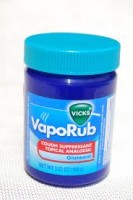
Because of the inherent make up of Vicks VapoRub, it does a better job of penetrating the nail to get to the source of the infection. This is a commonly recommended home remedy from physicians as they have seen improvements in patients who use this product. The petroleum jelly based mixture, infused with oils, such as menthol, allow for better infusion of the infected area.
Topical application is the only appropriate way to use Vicks VapoRub (after all, would you want to eat that stuff?) The “dose” is up to the applicant. The most common method of cure is to apply the substance to the affected nails and wear a sock or glove over the treatment. To prevent a re-occurrence of infection somewhere else, as fungus loves a moist environment, make certain to use a sock or glove that is 100% cotton for breath-ability.
Remedy suggestion #4: Tea Tree Oil
Tea Tree Oil, or Melaleuca Alternifolia has been found to be an effective natural anti-fungal. When applied in vitro (meaning poured into a dish, thus soaking like many of the other listed methods) Tea Tree Oil was found to discourage fungus growth in all of the common causes of onychomycosis, including Trichophyton mentagrophytes, Trichophyton rubrum, and Candida infections. Tea Tree Oil has been used in clinical trials and one of them reported a 20% cure rate while the other reported a 0% cure rate. The determining factor seems to be using 100% Tea Tree Oil instead of a diluted solution. The appearance of the nail fungus seemed to improve in people who used the 100% solution. Tea Tree Oil is recommended as a topical solution for many skin fungus conditions and has been seen to be effective in treating tinea pedis, a minor foot fungus. This is probably because the Tea Tree Oil is able to penetrate the infected area, thus reaching and eradicating the fungus.
Remedy Suggestion #5: Green Tea Extract
Camellia Sinensis or Green Tea Extract is another herbal remedy that has shown antifungal properties. When applied in vitro (in a dish) Green Tea Extract proved able to kill Candida glabrata. No one has done clinical trials with this herbal remedy so its effect on dermatophyte, and therefore onychomycosis is currently unknown.
A Quick Overview of Toenail Fungus Treatment Options
A Quick Overview of
Toenail Fungus Treatment Options
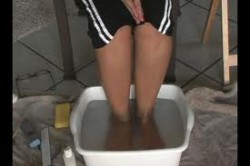 Toenail fungus is one of the most common and contractible diseases, as well as one of the most difficult to cure. The first thing you have to do is determine the cause of the infection. Is it fungal, bacterial, something else? And which kind of nail fungus is it? Is it Dermatophyte or yeast? Once your doctor has identified the source of the infection you can determine the course of treatment. Many people choose the home remedy path and find it very effective. Please note, if your nail fungus infection has reached the point where there is pain and/or drainage (oozing pus) you are well past the point where home remedies of any kind will work. If this is the case, you will need to find a standard medical solution to your problem.
Toenail fungus is one of the most common and contractible diseases, as well as one of the most difficult to cure. The first thing you have to do is determine the cause of the infection. Is it fungal, bacterial, something else? And which kind of nail fungus is it? Is it Dermatophyte or yeast? Once your doctor has identified the source of the infection you can determine the course of treatment. Many people choose the home remedy path and find it very effective. Please note, if your nail fungus infection has reached the point where there is pain and/or drainage (oozing pus) you are well past the point where home remedies of any kind will work. If this is the case, you will need to find a standard medical solution to your problem.
Home remedies really are effective, especially in treating toenail fungus. Many people consider alternative medicine to be “hippy dippy” or “out there” but something to consider is that only a couple hundred years ago, “alternative medicine” was the only medicine available. Many of the home remedies currently recommended are sometimes more effective than their standard medicine counterparts.
Some of these methods might sound a bit off-the-wall, but the science behind them is quite sound. Many of the natural fungicides recommended and available on the market are faster acting than some oral prescriptions. Soaking your feet in vinegar may sound gross, not to mention smelly, but vinegar has been used for centuries as a powerful disinfectant. Again, these are remedies to be tried in the early stages of nail fungus infection. Once the toenail fungus has caused the nail to separate from the nail bed, immersing your feet in vinegar or Listerine will be very painful, very quickly.
The modern medical community has created its own solutions to the problem of toenail fungus by producing various pharmaceutical products to treat the infection. If you have caught the infection early on, it is most likely that your doctor will prescribe a clear coat medicated nail polish. If the infection isn’t cleared up by this product, the next stage is to try an oral antifungal medication. This is a step that should only be taken while under the care of a medical professional as some of these products carry the risk of serious side effects and internal organ damage. You will have to check in with your doctor regularly if you choose this option, which does make it very expensive. You will also need to let your doctor know all medications, supplements and herbal remedies you are taking as this will reduce the possibility of a negative drug reaction during the course of your treatment.
The best cure for toenail fungus infection is prevention and/or early detection. Most people don’t notice a toenail fungus infection until it has progressed fairly far along as this is not something that causes significant discomfort and as it is not a regularly exposed area, people aren’t that concerned about it. The sooner you act to kill the invading toenail fungus, the easier it will be to make their extermination permanent.
Curing a Nail Fungus Infection with an Acidophilus Beer Soak
Curing a Nail Fungus Infection
with an Acidophilus Beer Soak
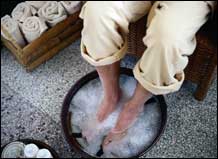 A nail fungus infection is unattractive at best, annoying at worst. This is not a disease that is going to kill you. It may affect how you interact with the world if it gets to bad, for instance, if your have a very bad toenail fungus infection, it may become painful to walk, or the nerves in your feet may be mildly affected and you won’t be able to feel the floor very well. However this is not a life threatening condition, especially if it is caught early on.
A nail fungus infection is unattractive at best, annoying at worst. This is not a disease that is going to kill you. It may affect how you interact with the world if it gets to bad, for instance, if your have a very bad toenail fungus infection, it may become painful to walk, or the nerves in your feet may be mildly affected and you won’t be able to feel the floor very well. However this is not a life threatening condition, especially if it is caught early on.
A fungus, most commonly a dermatophyte, can get onto and underneath your nail and find a happy, warm, moist place to grow. Once the fungus has established itself, it turns your nail white or yellow. This is usually seen originally as a spot, but that spot grows to cover the whole nail over time. It also makes your nails thicker and more brittle, because the fungus is consuming the keratin, the protein that your nails are made of, to grow and protect itself.
So one of the biggest problems with a fungal nail infection is that it is located underneath the nail, in the nail bed. One of the most frequently suggested nail infection home remedies is soaking your feet in a combination of dark beer, vinegar and acidophilus, usually referred to as an acidophilus beer soak.
So Why Acidophilus and Beer?
The theory behind this home remedy is that by soaking your infected nails in this solution for 20-30 minutes, you allow the alcohol in the beer to soften up the nail, thus the acidophilus and vinegar can get into and underneath the nail to kill off the fungal infection.
Here is the process:
• Use a dark beer, like Guinness Stout. (Any stout will do, most people happen to know and can get this particular brand.)
• Mix the beer with a ½ cup of white or apple cider vinegar.
• Add a sachet of acidophilus culture. You can find these at your health food store. You want to find one that is 125 billion organisms. (It should say so on the packaging.)
• Stir these all together, then soak the infected nails in the solution for 20-30 minutes a day, twice daily.
• Wash the infected area thoroughly with soap and water afterward, then dry equally thoroughly.
• Put on clean socks (if it is the beginning of the day) or leave your feet exposed to light and air.
This mixture can be used up to four times before disposing of it, which will keep your costs down. Many people have claimed to cure their nail fungus infection entirely by using this simple home remedy.